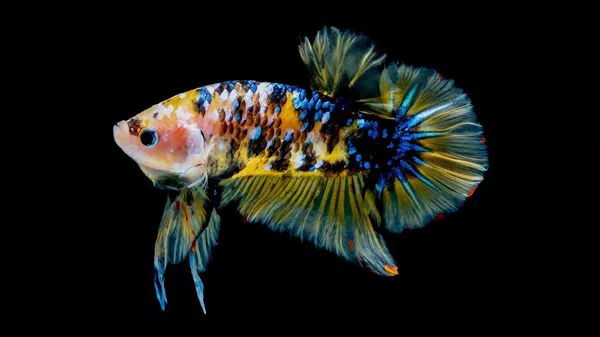Lungfish, one of the oldest and most fascinating groups of fish on the planet, have intrigued scientists, researchers, and pet enthusiasts alike for centuries. With their ability to breathe air and survive in conditions that would be fatal to most other fish, lungfish are often considered a living bridge between fish and land-dwelling animals. In this article, we will explore whether lungfish have air sacs, what these sacs are, and how lungfish utilize them in their survival strategy. Additionally, we will look at the different types of lungfish, their anatomy, and how they thrive in their natural habitats.
What is a Lungfish?
Lungfish are a unique group of freshwater fish belonging to the order Dipnoi. They are closely related to the ancestors of amphibians and share certain characteristics that provide a clue to their evolutionary past. There are only six known species of lungfish, which can be divided into three main families: the African lungfish, the South American lungfish, and the Australian lungfish. Despite the differences in their distribution and behavior, these fish share the remarkable ability to breathe air, an adaptation that has allowed them to survive in oxygen-depleted waters and harsh environmental conditions.
Lungfish are mostly found in stagnant, slow-moving waters such as swamps, lakes, and rivers, where the oxygen levels are often too low for most other fish to survive. These areas tend to have high temperatures, low water flow, and seasonal droughts, all of which can cause the water’s oxygen content to decrease dramatically. To cope with these conditions, lungfish have developed a set of extraordinary adaptations.
What Are Air Sacs?
Air sacs, also known as lungs, are specialized organs that allow an organism to take in oxygen from the air. While most fish rely on gills to extract oxygen from water, lungfish possess both gills and lungs. The lungs of lungfish are somewhat different from those found in mammals or birds. They are primarily adapted for extracting oxygen from air, which is a critical survival trait for lungfish living in oxygen-poor environments.
In lungfish, the air sacs are elongated, sac-like structures that can be found in the upper portion of their bodies. These sacs allow lungfish to take in air and extract the oxygen they need to survive when the oxygen in the water is insufficient. The presence of these air sacs makes lungfish one of the few groups of fish capable of true aerial respiration.
Do Lungfish Have Air Sacs?
Yes, lungfish do have air sacs, and these organs are essential for their survival. The air sacs are located in the body cavity, just behind the head and near the gills. They allow the lungfish to gulp air from the surface of the water, which is then absorbed into the blood for oxygen exchange. This adaptation is especially useful in the types of habitats where lungfish are found—places where the oxygen content in the water can be dangerously low.
However, it’s important to note that the air sacs are not just passive organs; they actively participate in the lungfish’s respiratory process. In addition to being able to gulp air when necessary, lungfish can also use their gills for underwater respiration when there is enough dissolved oxygen in the water. This ability to switch between two forms of respiration—gill breathing and air breathing—gives lungfish a great advantage in survival.
How Do Air Sacs Work in Lungfish?
The air sacs of lungfish function in a manner similar to lungs in terrestrial animals, but with some key differences. When lungfish surface, they gulp air, and the air enters the air sac through a tube-like structure called the spiracle. The spiracle is a small opening located near the gills, which helps the fish to draw air into its lungs while its body remains submerged. The air sac acts as a reservoir, where the oxygen is absorbed into the bloodstream, supplying the fish with the oxygen it needs for metabolism.
In terms of structure, the lungs (or air sacs) of lungfish are relatively simple compared to the complex lungs of mammals or birds. They are typically sac-like and composed of a spongy tissue that allows the absorption of oxygen. The air sacs are connected to the esophagus and are lined with a thin layer of tissue, which facilitates the transfer of gases between the air and the blood.
Interestingly, while most lungfish can breathe air, the process is not as efficient as it is in land animals. This is due to the fact that the air sacs of lungfish are not as developed as the lungs of mammals. Consequently, lungfish may need to surface more frequently to gulp air, especially in low-oxygen environments.
The Importance of Air Sacs in Lungfish Survival
The air sacs of lungfish are a vital adaptation for their survival in the environments they inhabit. Many of the freshwater habitats where lungfish are found experience seasonal changes that lead to fluctuations in oxygen levels. During periods of drought, water levels drop, and the remaining water becomes warmer and more stagnant. This decreases the dissolved oxygen levels in the water, making it difficult for gill-breathing fish to survive. Lungfish, however, are equipped to survive these conditions thanks to their ability to gulp air.
When oxygen levels in the water become too low, lungfish can enter a state called “aestivation.” Aestivation is a form of dormancy that allows the lungfish to survive in a dormant state for extended periods, often months. During this time, the lungfish retreats into the mud or burrows itself into the sediment of dried-out ponds or rivers. The air sacs allow the fish to continue breathing by gulping air when necessary, even though it is buried in the mud. This remarkable survival strategy enables the lungfish to endure the harshest conditions until water levels rise again.
Types of Lungfish and Their Adaptations
Lungfish are divided into three major families, each of which exhibits unique adaptations related to their air sacs and survival strategies. Let’s take a closer look at the three main types of lungfish:
1. African Lungfish (Family: Protopteridae)
The African lungfish is perhaps the most well-known species and is often studied for its impressive survival strategies. African lungfish are capable of surviving prolonged droughts by burrowing into the mud, where they enter a state of aestivation. During this time, they rely on their air sacs to breathe, while their metabolism slows down significantly. African lungfish are also known for their ability to regenerate damaged tissues, making them a subject of medical interest.
These lungfish have relatively simple, yet highly functional, air sacs. The African lungfish’s lungs are quite large compared to its body size, which allows it to store more air. This adaptation helps it survive when the surrounding water is devoid of oxygen.
2. South American Lungfish (Family: Lepidosirenidae)
The South American lungfish is another fascinating species that relies on its air sacs for survival. These lungfish are found in slow-moving rivers and lakes, where they can remain submerged and use their gills for respiration when oxygen levels are sufficient. However, during the dry season, South American lungfish are capable of entering a state of dormancy, during which they rely exclusively on their air sacs for breathing.
South American lungfish possess a pair of large air sacs that are highly vascularized, making them efficient at absorbing oxygen. Their lungs also help them expel carbon dioxide, and some studies suggest that they can even “breathe” underwater through their skin if necessary.
3. Australian Lungfish (Family: Ceratodontidae)
The Australian lungfish is the most primitive of the three main lungfish families and has both gills and lungs. Unlike the African and South American lungfish, the Australian lungfish’s air sacs are not as highly developed, but they are still functional for aerial respiration. Australian lungfish are found in clear, slow-moving rivers and lakes, where the oxygen levels are relatively stable, and they primarily use their gills for breathing.
While the Australian lungfish does not rely on its air sacs as heavily as the other species, it still retains the ability to gulp air when needed. This ability gives it an advantage when environmental conditions change, and it may need to survive in oxygen-depleted waters.
Conclusion
Lungfish are an exceptional example of evolutionary innovation, and their air sacs play a crucial role in their survival. These fascinating fish have adapted to life in oxygen-poor environments, where their ability to breathe air has allowed them to thrive. Whether it is the African lungfish’s ability to survive in dried-up mud, the South American lungfish’s seasonal dormancy, or the Australian lungfish’s reliance on both gills and lungs, the presence of air sacs is central to their existence.
The air sacs of lungfish are a testament to the remarkable ways in which animals can adapt to their environments. By developing the ability to breathe both in water and air, lungfish bridge the gap between aquatic and terrestrial life, offering a unique window into the evolutionary process. As we continue to study these ancient fish, we gain a deeper understanding of how life on Earth evolved and how organisms have managed to survive in even the harshest conditions.
Related Topics:





















